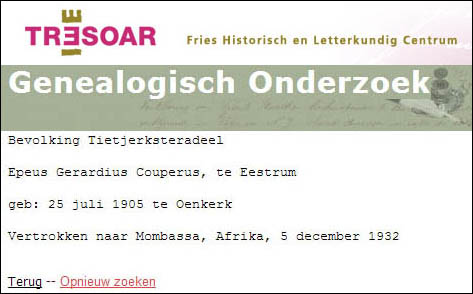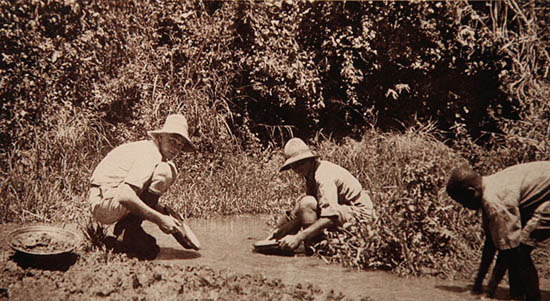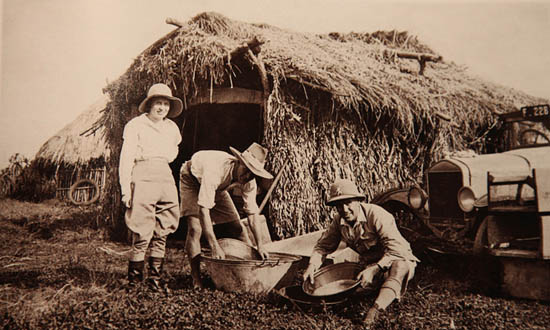
As mentioned earlier, according to the Frisian emigration archives, my Dad left for Africa again on Sinterklaas day (5 December) 1932.
 |
Fortunately, I did realise that Tante Jans (second wife of Piet Oosterchrist) would know some of the details and I asked her to write them down not long before she died. I reproduce
the letter below with some editorial comments inserted by me like this in italics to clarify and explain certain references.
Here is the letter she sent me:
|
Thus my father arrived back in Uganda to work in the role of a general kind of support person for the mining and prospecting camps, but now in the employ of Billiton rather than The Baroness.
 |
 |
Some of the work was to perform further prospecting for minerals, but the company had also purchased some mining rights in areas where they thought there might be alluvial gold that could be panned out of the rivers in that area - hoping for an easy "quick return" to keep the shareholders of the company happy while they looked for any substantial deposits of other minerals.
But reading between the lines of Jans Oosterchrist's letter above as well as what I gathered from my Dad, "Miss Ledeboer" who was a geologist on the expedition (and as a "professional" was probably senior to my Dad who was basically a glorified errand boy) became enamored of the Italian "Count Davico" and pulled strings for him to take over the job my Dad had.
This might have been a problem except that during his brief stay in Holland between the two expeditions, and at the request of George Ismail, my Dad had looked around to identify companies in Holland
that might be interested and suited to opening an import/export business in Uganda. One of the names he came up with was that of a company based in the town of Enschede in the province of Twente in Holland.
I mention this location because it helps in understanding the name of the company "Twetsche Overseas Trading Company" (or in Dutch "Twentsche Overzee Handelmaatschappij".
This company had been founded in 1920 by a consortium of textile factories in the Province of Twente to export their cotton textiles for which the region was well known.
 |
This company had come to my Dad's attention because he found out that they already had an office in Mombasa, the main port city on the coast of Kenya and through which one invariably had to pass to gain access to the hinterlands of Kenya and Uganda. There was no other way in the absence of air transport which had not yet arrived in those parts.
He and George Ismail accordingly approached the manager of the company in Mombasa (a Mr Oostdam) about the possibility of opening up a branch in Uganda. The timing was fortuitous because a member of the Board of Directors of the Dutch company just happened to be on an inspection visit to Mombasa and had already suggested that a branch office be opened in Nairobi (the main town in Kenya) - so a suggestion that a branch be simultaneously opened in Kampala (the main town in Uganda) - and for which an Dutchman with local experience was already available to set up the operation - what could be better?
And thus it was the a branch of the "Twentsche Overzee Handelmaatschappij" was established in Kampala, with Mr E.G. Couperus as its first manager.
But while all this was going on, another event occurred which was to have a significant impact on the subsequent course of the Family History.